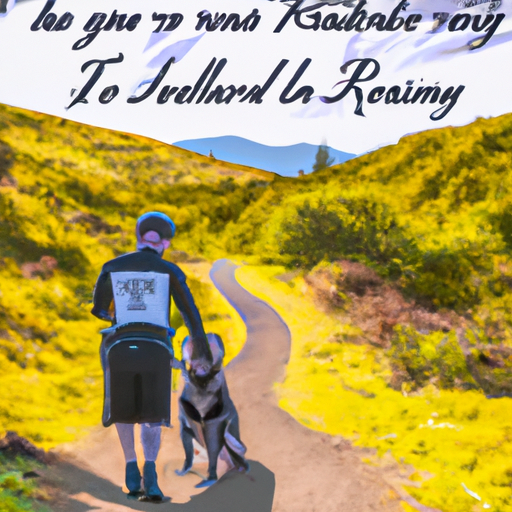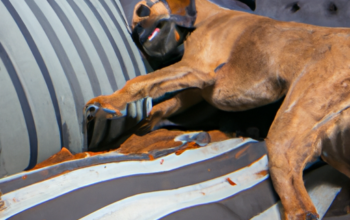Imagine a world where over 285 million people face the daily challenge of navigating their surroundings without the gift of sight. This is the reality for those living with visual impairments, but there’s hope. Thanks to guide dogs, countless individuals facing this adversity have found newfound freedom and independence in their lives.
You might be wondering how these incredible animals are able to assist their handlers in overcoming such immense challenges. The answer lies in the rigorous training process they undergo, as well as the deep connection and mutual understanding that develops between handler and guide dog.
In this article, we’ll explore the remarkable journey of guide dogs and their handlers – from training to teamwork, through obstacles and triumphs – all while highlighting inspiring stories that showcase determination, resilience, and an unbreakable bond between human and canine partners.
The Rigorous Training Process for Guide Dogs
You’ll be amazed to learn about the rigorous training process that future guide dogs must undergo before they’re ready to assist their handlers. Training techniques are designed to harness canine intelligence and instill a deep sense of responsibility in these extraordinary animals.
From as early as eight weeks old, puppies begin their journey with socialization exercises and basic obedience training, gradually progressing to more advanced skills such as navigating obstacles, stopping at curbs, and even understanding traffic patterns.
Empathy plays a significant role in the relationship between guide dogs and their handlers; thus, it’s an essential part of the training process. These incredible canines learn how to anticipate and adapt to their handler’s needs by reading subtle body language cues and responding accordingly.
The bond formed between them is one of mutual trust, respect, and unwavering loyalty – a partnership that not only provides invaluable assistance but also brings immeasurable joy and companionship into each other’s lives.
As you delve deeper into this fascinating world of guide dogs, you can’t help but feel inspired by their dedication to serving others and making a positive impact on countless lives.
Developing Deep Connections and Mutual Understanding
It’s in this remarkable partnership where deep connections and mutual understanding truly blossom, opening up a world of possibilities for both the guide dog and its handler.
Canine communication is key to developing this special bond, as handlers learn to interpret subtle cues from their dogs, such as changes in body posture or vocalizations. Trust-building exercises are essential in establishing a strong foundation for this relationship; after all, the two must rely on each other to navigate through life safely and confidently.
As you embark on this incredible journey together, you’ll find that it’s not just about physical guidance – it’s also an emotional connection that transcends words.
Take a moment to appreciate the profound impact these dedicated animals have on their handlers’ lives. This symbiotic relationship goes beyond mere assistance; it fosters self-reliance, independence, and even personal growth.
As you witness the amazing feats accomplished by guide dogs and their handlers every day, remember that there’s more than meets the eye – there’s a story of love, trust, and unwavering dedication behind each team.
Embrace the opportunity to serve others by supporting guide dog programs or simply sharing stories of these extraordinary partnerships with those around you; after all, everyone deserves a chance to chart new paths toward limitless possibilities.
Overcoming Challenges Faced by Guide Dog Teams
As you navigate the world with your loyal companion, you’ll undoubtedly encounter obstacles that test your bond and resilience, but overcoming these challenges will only strengthen your partnership and deepen your connection.
One of the most common issues faced by guide dog teams is dealing with public misconceptions about the role and abilities of guide dogs. Many people may not understand the level of training and dedication required from both handler and canine, nor do they fully grasp how essential this partnership is for navigational independence. It’s important to remain patient when educating others about your unique relationship, as raising awareness can help dispel these misconceptions and create a more understanding environment for all.
Another challenge you may face as part of a guide dog team is adapting to new or changing environments, which can be disorienting for both you and your four-legged friend. Unexpected detours, construction zones, or unfamiliar territories might require extra effort from both parties to maintain a sense of direction and stay on track. In these moments, it’s crucial to trust in each other’s capabilities while also being prepared to seek assistance if needed.
Remember that just as much as you rely on your guide dog’s expertise in navigation, they depend on you for guidance in situations that might be out of their realm of experience. By facing these hurdles together with confidence and perseverance, you’ll continue to grow as a team – transcending boundaries, breaking stereotypes, and inspiring others who dream of achieving similar levels of independence through service dogs.
Life-Changing Impact on Handlers
There’s no denying the profound impact these amazing animals have on their handlers’ lives, transforming everyday experiences and opening up a world of possibilities. Navigating independence becomes less daunting as guide dogs provide a sense of security, allowing their handlers to confidently explore new environments.
Empowering partnerships are formed between handler and guide dog; working together seamlessly as a team to overcome challenges and live life without limitations. These remarkable dogs offer so much more than just physical assistance; they also bring emotional support, companionship, and unconditional love.
Just imagine the ways in which your life could be enriched by having such an incredible partner by your side:
- Increased confidence: With a guide dog at their side, handlers can move through the world with greater self-assurance, knowing that they have a reliable companion watching out for them.
- Expanded social opportunities: The presence of a guide dog often sparks conversations with strangers, providing new opportunities for engaging with others and forming meaningful connections.
- A renewed sense of purpose: Caring for an animal can give handlers a newfound purpose in life, fostering feelings of responsibility and pride as they work together towards achieving mutual goals.
The bond between handler and guide dog is truly extraordinary – it’s not just about navigating the physical world but experiencing life on a deeper level through trust, understanding, and shared experiences. By taking on this unique partnership role in serving others alongside their furry companions, individuals are granted the opportunity to see firsthand how these canine heroes truly transform lives for the better.
Inspiring Stories of Determination and Resilience
You might be amazed to learn that over 10,000 visually impaired people in the United States currently rely on guide dogs, showcasing their determination and resilience to conquer life’s challenges together. These triumphant partnerships between handlers and their four-legged companions not only create an unbreakable bond but also inspire others with their unwavering perseverance. The incredible stories of these teams demonstrate how they navigate daily obstacles and achieve what may seem impossible for some.
One way to truly appreciate the determination and resilience of guide dog teams is by exploring some inspiring stories:
| Guide Dog Team | Remarkable Achievement |
| — | — |
| Roselle & Michael Hingson | Survived the 9/11 attacks on the World Trade Center |
| Klinger & Lt. Col. (Ret.) Kathy Champion | Completed multiple marathons together |
| Lucca & Marine Staff Sgt. Chris Willingham | Served two tours in Iraq as a specialized search dog |
These amazing tales highlight how guide dogs help their handlers maintain independence, confidence, and security while facing life’s challenges head-on. It is through these powerful partnerships that we can all gain insight into our own potential for overcoming adversity with courage, determination, and compassion for others.
Frequently Asked Questions
What is the selection process for dogs to become guide dogs? Are certain breeds more suitable than others?
When considering the selection process for guide dogs, it’s essential to understand that specific breeds often possess traits making them more suitable candidates. Guide dog breeds typically include Labrador Retrievers, Golden Retrievers, and German Shepherds due to their intelligence, temperament, and adaptability.
The selection criteria involve evaluating each dog’s health, confidence, focus, and willingness to work in partnership with a handler.
While embarking on this noble journey to serve others by providing mobility assistance and companionship, it’s crucial to empathize with both the handler and the canine partner.
By delving deep into these aspects of guide dog training and understanding how certain breeds excel in this role, you’ll gain valuable insight into the incredible world of service animals dedicated to enhancing lives every day.
How long does it take for a guide dog to retire, and what happens to them after retirement?
As the sun sets on their working days, guide dog bonds transition into a new chapter of life – retirement. Typically, these devoted companions retire around the age of 8 to 10 years old, but this can vary depending on their health and abilities.
Retirement celebrations may ensue as they pass the baton to a younger successor, allowing them to enjoy their golden years with well-deserved rest and relaxation. During this time, they often continue living with their handler’s family or may be adopted by other loving homes that cherish the noble work they’ve accomplished throughout their lives.
Ultimately, these faithful friends are rewarded with endless affection and gratitude for having served as such selfless navigators in charting new paths for those who rely on them most.
What is the approximate cost of raising, training, and maintaining a guide dog throughout its working life?
As you consider the rewarding journey of partnering with a guide dog, it’s important to be aware of the guide dog expenses involved in raising, training, and maintaining these incredible animals.
From their early days as puppies to mastering advanced training techniques, the cost can range between $40,000-$60,000 throughout a guide dog’s working life. This investment not only ensures that these dogs are well-equipped to assist individuals with visual impairments but also fosters a deep bond built on trust and mutual support.
While this sum may seem substantial, keep in mind that your partnership with a guide dog will provide immeasurable benefits in terms of independence and quality of life – making it truly priceless for those dedicated to serving others.
How do guide dogs navigate public transportation and busy urban environments, such as crossing streets and maneuvering through crowds?
Navigating urban challenges with your guide dog is a testament to the power of trust and canine communication. Your dog’s keen senses and training enable them to expertly guide you through complex environments. They’ll lead you safely around obstacles, pause at curbs or stairs, and even locate empty seats on public transportation.
The intuitive bond between you two allows for seamless navigation, transforming overwhelming cityscapes into manageable journeys filled with mutual understanding and unwavering support.
Are there any legal protections in place to ensure that guide dogs and their handlers are allowed access to public spaces and services?
Absolutely! Legal safeguards are in place to ensure that you and your guide dog enjoy accessibility rights when it comes to public spaces and services. Thanks to laws like the Americans with Disabilities Act (ADA) in the United States, businesses and public accommodations must allow individuals with disabilities, including those using guide dogs, equal access to their premises.
This means that restaurants, hotels, stores, taxis, and even airplanes cannot deny entry or service based on the presence of a guide dog. It’s essential to be aware of these protections so you can confidently navigate everyday life alongside your four-legged companion while making a positive impact on those around you who may not yet understand the vital role guide dogs play in promoting independence for people with visual impairments.
Conclusion
Imagine yourself, for a moment, walking through the bustling streets with your guide dog at your side, navigating the world together.
You’ve both overcome countless challenges and formed an unbreakable bond that transcends mere companionship.
As you stride forward into the unknown, remember the incredible journey you’ve embarked on with your loyal companion.
Your resilience and determination shine brightly like beacons of hope to others who may follow in your footsteps.



